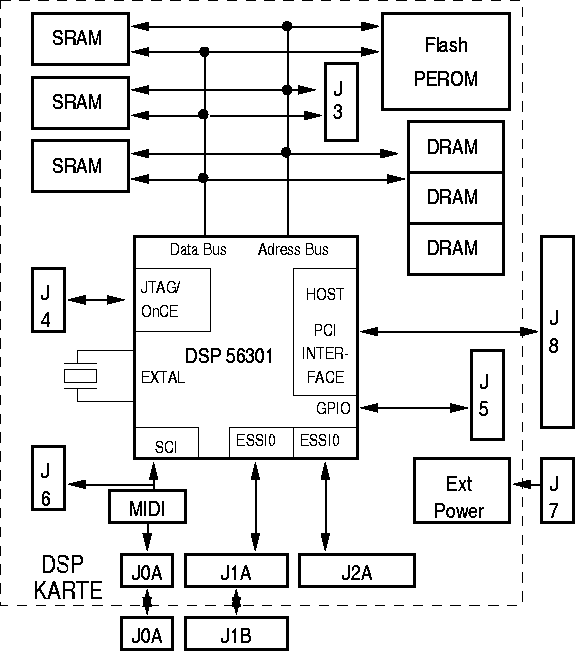DSP-Card
Next: The DSP Up: Hardware Previous: Hardware
Subsections
DSP-Card
The DSP-Card should satisfy following criterias:
| free programmable DSP | simple implementation of the software of hardware-modules and algorithmic-modules. |
DMA - possibilities |
fast transfer of data from/to the I/O-modules from/to/within the host-computer |
IRQs |
Interruptdriven device-drivers on hostside |
busmaster possibilities |
writing and reading from the RAM of the host from the DSP-card to store big amounts of data (multichannel) on the host RAM or doing routings of data on the host side. communication with other dsp-cards. |
standard DSP-IO (SSI, ESSI bus) |
to connect more than one and different I/O-module to the DSP-card to get different hardware solution for ADDAs and other equipment. |
MIDI |
MIDI-Interface for communication with other Music-Devices like Synthesizer, ... |
Standalone |
The DSP-card should work also withaout a hostcomputer as Standalone DSP-device with extern power-supply to use as effect, audiomatrix, MIDI-Device. |
The DSP card is a card with the Motorola DSP56301 on the PCI bus. For the development and as test device the evaluation ''Motorola DSP56303EVM'' board in connection with the ISA bus INTERFACE of Signallogic can be used. Also the soundcard ''Tahiti multi-sound'', which uses a DSP56002, can be used as equivalent hardware on ISA bus base 1.1. There are already further cards with this processor announced at the market, which can be used also with special limitations of I/O software modules.
Only the PCI bus enables the full ''performance'' for multi-channel systems, since the card can act as several DMA-channels by means of the DSPs to/from/within host-memory.
A further advantage is that the DSP card can act as ''master'' at the PCI bus and thus independently access to RAM or several cards.
From the request the blockdiagram 1.1 results with the following ports:
| port J | description |
| 0A | MIDI/RS232 intern |
| 0B | MIDI/RS232 extern |
| 1A | DSP-0 bus intern |
| 1B | DSP-0 bus extern |
| 2A | DSP-1 bus intern |
| 3 | I/O Bus for expansion boards |
| 4 | JTAG, Once Port for debugging |
| 5 | general purpose I/O-Pins (e.g. for standalone) |
| 7 | external power supply (für Standalone Ausführung) |
| 8 | PCI-Bus |
Features
- DSP 56301
- PCI-Bus
- MIDI-Interface (or RS232-Interface)
- 2 ESSI-bus in Asynchron- or synchron-mode with bus driver
- SRAM 32K Words (24Bit), optional (should be updated to 128k SRAM)
- Flah EEPROM, optional
- Standalone Mode (Boot from EEPROM), optional
- DRAM 512k...12Mwords, optional
- Free seriell I/O-BitBus
The SRAM and EEPROM connection are the same as on the EVM56303 from Motorola.
MIDI-Interface - RS232
The standard MIDI-INTERFACE is implemented, with opto coupler on the card, so that only a cable is required to connect to other MIDI devices.
Optionally it could be implemented as RS232 by removeing the MIDI-circuits and the RS-232 is routed directly on the MIDI plug (also internal wiring possible). The Baud rate and bitcount are freely programmable in the boundaries of the DSP, whereby naturally the clock rate of the CCU is important for the baudrates. Optional a crystal for special clockrates can be mounted.
SRAM
the 32kx24 SRAM (12ns) is also optional and is needed for memory-intensive or more complex algorithms, if that does not fit into the internal RAM of the DSP.
For next releases 128kx24 and more is planed.
DRAM
who needs much RAM, for example for Samples or Delays, can use DRAM (however slow) optionally installed on the expansion bus, whereby this can be max. 8 Mwords (24 Bit) where you need a 32MB-simm where only the 24Bit of the 32Bit are used.1.2. Also if 5V-DRAM is used there is a need for the voltage converter to the 3.3V interface.
It is mainly meant for the standalone operation, since otherwise the host memory could be used over the PCI bus.
Flash EEPROM
into the Flash EEPROM (also optionally) the DSP program can be stored. and the DSP can boot if necessary from these. This is necessary for the standalone operation. Further important configuration data could be stored in de EEPROM.
Standalone mode
If a special application without host operation was programmed, it can be stored and executed from the EEPROM. Thus the card without PC is operable. For this mode however a termination plug at the PCI connecter is needed, where also the power supply is added for the card. The PCI-pins can be used as general purpose pins, which should be avoided when used in both standalone and host mode.
In our case there is a project particularly of a makein pitch analysis and envelope following, where the data is sent over the MIDI interface and the card is controlled from there.
It is also possible to operate own hardware over the expansion board (switch, LCD Display,...).
Next: The DSP Up: Hardware Previous: Hardware HAss.DI Winfried Ritsch - ritsc@iem.kug.ac.at


